Q1. Recognise the parts in the diagram of a typical leaf given below.


Solution
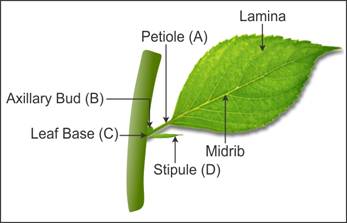
Q2. Bicarpellary, syncarpous ovary with axile placentation is seen in the
plants of family
Solution
The gynoecium in the Solanaceae family is bicarpellary, syncarpous,
with an ovary which is superior and bilocular, and the placenta is swollen
with many ovules. The placentation is of axile type.
Q3. Vexillary aestivation is characteristic of family
Solution
Vexillary aestivation is characteristic of family Fabaceae. In this type of aestivation, the largest (standard) overlaps the two lateral petals (wings) which overlap the two smallest anterior petals (keel).
Q4. Explain the following terms:
(a) Perigynous flower
(b) Hypogynous flower
(c) Epigynous flower
Solution
(a) Perigynous flower: The gynoecium is located in the centre, and other parts of the flower are located on the rim of the thalamus almost at the same level.
Examples: Rose, peach
(b) Hypogynous flower: The gynoecium is located at the highest point, i.e. the ovary is superior and the other parts are situated below it.
Examples: China rose, brinjal
(c) Epigynous flower: The margin of the thalamus grows over and encloses the ovary completely. The margins of the flower get fused with the other parts of the flower which rise above the ovary.
Q5. Define
thalamus.
Solution
The
thalamus is the swollen end of the pedicel on which the four whorls, i.e.
calyx, corolla, androecium and gynoecium, are arranged.
Q6. Define
fruit. Give two examples of a drupe.
Solution
A fruit
is a mature ripened ovary developed after fertilisation. Mango and coconut
are examples of a drupe.
Q7. The fibrous root system is mostly found
in
Solution
In monocots, the primary root is short
lived. It is replaced by a large number of roots which originate from the
base of the stem. These roots constitute the fibrous root system.
Q8. Write the
vegetative characters of the family Fabaceae.
Solution
The
vegetative characters of the family Fabaceae are as follows:
1. The
stem is erect or a climber.
2. Leaves
are alternate, pinnately compound or simple. The leaf base is pulvinate, stipulate and leaf venation is reticulate.
Q9. Colchicine is obtained from which of the following families?
Solution
Colchicine is extracted from the plant Colchicum autumnale which belongs to family Liliaceae.
Q10. Describe vexillary aestivation with the help of a diagram.
Solution
 In vexillary aestivation, there are five petals. The largest petal (called standard) overlaps the two lateral petals (called wings) which further overlap the two smallest anterior petals (called keel).
In vexillary aestivation, there are five petals. The largest petal (called standard) overlaps the two lateral petals (called wings) which further overlap the two smallest anterior petals (called keel).
Q11. A flower which can be divided into equal
vertical halves by more than one plane of division is
Solution
Floral symmetry is the shape, size and
arrangement of floral appendages around the axis of a flower. On the basis of
floral symmetry, three conditions are seen in flowers:
1. Actinomorphic: Flowers are with
radial symmetry. A flower can be divided into two equal radial halves in any
radial plane passing through its centre.
Example: Datura
2. Zygomorphic: These flowers can be
divided into halves only in one plane.
Example: Pea
3. Asymmetric: Flowers are cannot be
divided into equal halves in any vertical plane.
Example: Canna
Q12. The edible part in litchi is
Solution
Aril is a fleshy covering on the seed,
arising as an upgrowth of the funicle or base of the ovule. It is the aril of
litchi which we eat.
Q13. Name the roots which arise from any other plant
part.
Solution
The roots which arise from any other plant
part except radicle are called adventitious roots.
Q14. Pneumatophores are present in
Solution
Halophytes are the plants found in areas
of high salinity such as estuaries and marshy regions. These plants are
usually rooted in water logged, anaerobic mud. Many roots come out of ground
and grow vertically upwards to get oxygen for respiration. These roots are
called pneumatophores.
Q15. Find the odd one out.
Solution
Radish is an example of a fusiform root,
whereas the rest are examples of a napiform root.
Q16. A horizontal underground stem is a
Solution
Rhizomes are also called root stalks. They are the underground growth
of plants from which the parts which grow above the ground develop. A rhizome
usually grows perpendicular to the direction of the force of gravity, i.e.
they grow horizontal.
Q17. What is
phyllotaxy? State the three types of phyllotaxy.
Solution
Phyllotaxy
is the arrangement of leaves on the stem or branch.
The three
types of phyllotaxy are as follows:
1.
Alternate
2.
Opposite
3.
Whorled
Q18. Write the
scientific name for the plant which belongs to the family Liliaceae and from
which colchicine is extracted.
Solution
Colchicum autumnale
Q19. The floral formula  is that of
is that of
 is that of
is that ofSolution
Tobacco belongs to family Solanaceae.
Characteristics of family Solanaceae:
Inflorescence: Cymose
Flower: Bracteate or ebracteate, bisexual, actinomorphic, pentamerous, hypogynous and valvate
Calyx: Five sepals, gamosepalous
Corolla: Five petals, gamopetalous
Androecium: 5 stamens, epipetalous
Gynoecium: Superior, bicarpellary, syncarpous ovary
Q20. Tobacco and Petunia belong to family
Solution
Tobacco and Petunia belong to family Solanaceae.
Q21. Draw a floral diagram for Solanum nigrum.
Solution
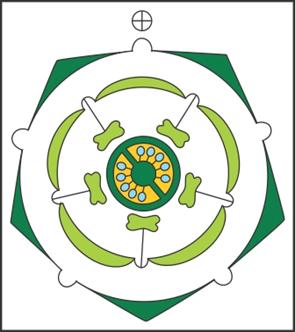
Q22. In monocotyledonous seeds, the endosperm is separated from the embryo by a distinct layer known as
Solution
The aleurone layer is the outer covering of the endosperm. It is proteinous in nature.
Q23. Vivipary is characteristic of
Solution
Vivipary is a special type of seed
germination which occurs in halophytes in which seeds germinate inside the
fruit when it is still attached to the parent plant.
Q24. A fruit developed from the hypanthodium
inflorescence is
Solution
Syconus fruit develops from hypanthodium
inflorescence. Example: Ficus carcia. In this type of inflorescence, the flask-shaped
receptacle encloses female flowers which give rise to achene-like
fruitlets.
Q25. Explain the three types of phyllotaxy and give examples of each type.
Solution
The three types of phyllotaxy are as follows:
1. Alternate type of phyllotaxy:
A single leaf arises at each node in an alternate manner.
Examples: China rose, Sun flower
2. Opposite type of phyllotaxy:
A pair of leaves arise at each node and lie opposite to each other.
Examples: Calotropis, Guava
3. Whorled type of phyllotaxy:
More than two leaves arise at a node and form a whorl.
Example: Alstonia
Q26. Distinguish
between reticulate venation and parallel venation.
Solution
Reticulate
Venation
Parallel
Venation
1. The veinlets form a network.
1. The veins run parallel to each
other within a lamina.
2. It is seen in dicotyledonous plants.
2. It is seen in monocotyledonous
plants.
Q27. The edible part of mango is
Solution
The mesocarp in mango is the middle
fleshy edible part.
Q28. Describe
the structure of a dicotyledonous seed.
Solution
A
dicotyledonous seed is covered by a seed coat.
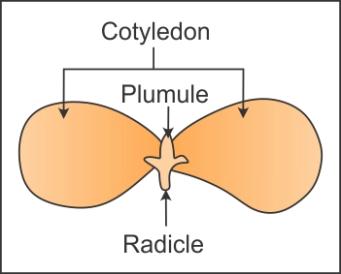 A seed
coat is made of two layers—an outer testa and an inner tegmen.
There is
a scar on the seed coat called hilum. Through the hilum, the developing seeds
are attached to the fruit.
A
micropyle is the small pore present just above the hilum.
An embryo
is enclosed by the seed coat.
The
embryo has an embryonal axis and two cotyledons.
The
cotyledons are fleshy, and they serve as the food reserves for the developing
embryo.
At the
two ends of the embryonal axis are the radicle and the plumule.
A seed
coat is made of two layers—an outer testa and an inner tegmen.
There is
a scar on the seed coat called hilum. Through the hilum, the developing seeds
are attached to the fruit.
A
micropyle is the small pore present just above the hilum.
An embryo
is enclosed by the seed coat.
The
embryo has an embryonal axis and two cotyledons.
The
cotyledons are fleshy, and they serve as the food reserves for the developing
embryo.
At the
two ends of the embryonal axis are the radicle and the plumule.
 A seed
coat is made of two layers—an outer testa and an inner tegmen.
There is
a scar on the seed coat called hilum. Through the hilum, the developing seeds
are attached to the fruit.
A
micropyle is the small pore present just above the hilum.
An embryo
is enclosed by the seed coat.
The
embryo has an embryonal axis and two cotyledons.
The
cotyledons are fleshy, and they serve as the food reserves for the developing
embryo.
At the
two ends of the embryonal axis are the radicle and the plumule.
A seed
coat is made of two layers—an outer testa and an inner tegmen.
There is
a scar on the seed coat called hilum. Through the hilum, the developing seeds
are attached to the fruit.
A
micropyle is the small pore present just above the hilum.
An embryo
is enclosed by the seed coat.
The
embryo has an embryonal axis and two cotyledons.
The
cotyledons are fleshy, and they serve as the food reserves for the developing
embryo.
At the
two ends of the embryonal axis are the radicle and the plumule.
Q29. Select the incorrect statement with respect to
twiners.
Solution
Specialised climbing organs such as
tendrils, thorns, spines and hooks are produced in climbers.
Q30. Which of the following represents the floral characters of Liliaceae?
Solution
Trimerous, actinomorphic, polyandrous, superior ovary and axile placentation are characters which represent the family Liliaceae.
Q31. Zygomorphic condition can be represented as
Solution
The ‘%’ sign is used to indicate the zygomorphic condition of flower.
Q32. Flowers in which only one set of
essential organs is present are said to be
Solution
In a unisexual, either an androecium or
a gynoecium is present.
Q33. Pulses such as gram, moong and soyabean belong to family
Solution
Gram, moong and soyabean belong to family Fabaceae.
Q34. The roots which penetrate the host tissues are
called
Solution
The roots of parasitic plants which
penetrate the host tissues to absorb nourishment are called haustorial roots.
Q35. Name the family
which was earlier known as Papilionoideae.
Solution
The
family Fabaceae was earlier known as Papilionoideae.
Q36. Write the floral formula for Asparagus.
Solution
The floral formula for Asparagus is


Q37. Explain
the different kinds of modifications of stem.
Solution
Modification
of stem:
1.
Underground stem: Stores food. It also acts as organs of perennation to face
conditions unfavourable for growth. Examples: Potato, turmeric
2. Stem
tendrils: They develop from axillary buds. They are slender, spirally coiled
and help plants to grow. Example: Pumpkins
3.
Thorns: Axillary buds get modified into thorns. They are woody, straight and
pointed.
They
protect plants from animals. Example: Citrus
4.
Photosynthetic stem: In arid regions, stems become flat and fleshy. They
contain chlorophyll to carry out photosynthesis. Example: Euphorbia
5.
Reproductive stems:
In some
plants such as Jasmine, a slender lateral branch arises from the base of the
main axis. After growing aerially for some time, it arches down to touch the
ground.
In plants
such as Chrysanthemum, the lateral
branches originate from the basal and underground portion of the main stem.
It grows horizontally beneath the soil and comes out obliquely upwards to
give rise to leafy shoots.
Q38. Some roots resemble the shape of pillars. In which
plants do we observe these roots?
Solution
In Banyan, the roots grow vertically
downward, penetrate the soil, become thick and assume the shape of pillars.
Q39. Define root cap.
Solution
The root cap is a
thimble-like structure which covers the apex of the root.
Q40. Cite examples
of non-endospermous seeds.
Solution
Examples
of non-endospermous seeds are as follows:
Bean,
gram, pea
Q41. If the position of the ovary is below the sepals, petals, stamens, the flower is called
Solution
In an epigynous type of flower, the ovary is fused and enclosed within the thalamus and the other parts rise above the ovary.
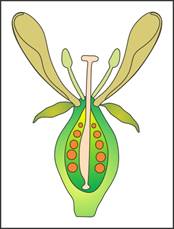

Q42. Pulvinus is seen in
Solution
The swollen leaf base is called pulvinus. It
helps to perform seismonastic movements in Mimosa pudica.
Q43. Which of the following is the correct arrangement of corolla in family Papilionoideae?
Solution
In family Papilionoideae, the corolla has 5 petals and is polypetalous. Two anterior petals form a keel which encloses the stamens and pistil. Hence, C1 + 2 + (2) is the correct option.
Q44. State the
three parts of a typical leaf.
Solution
The three
parts of a typical leaf are
1. Leaf
base
2.
Petiole
3. Lamina
Q45. State the function of the petiole.
Solution
The petiole holds the lamina. It helps the leaf to flutter in the wind, thus cooling the leaf.
Q46. The fruit of groundnut is
Solution
The legume or pod develops from a monocarpellary gynoecium. It is a
dry dehiscent fruit which occurs in Leguminosae plants such as pea, gram,
bean and groundnut.
Q47. Differentiate
between fibrous roots and adventitious roots.
Solution
Fibrous Roots
Adventitious Roots
1. Roots arise
from the base of the stem.
1. Roots arise
from the parts of the plant other than the radical.
2. It is found in
wheat.
2. It is found in
grass and banyan tree.
Q48. Find the odd one out.
Solution
Tridax is a decumbent trailer which branches
after growing horizontally for some length and then grows vertically upwards.
Q49. The plant which bears clinging roots is
Solution
Clinging roots are modified adventitious roots meant for providing
mechanical support. Examples: Orchids, ivy
Q50. The fruit of Mangifera indica is
Solution
Drupe in mango is the fruit which is one-seeded, simple, fleshy and develops
from a multicarpellary gynoecium.
Q51. Name the region of
the root which is responsible for the growth in length of the root.
Solution
The region of
elongation is responsible for the growth in length of the root.
Q52. Draw a well-labelled
diagram of a typical leaf.
Solution
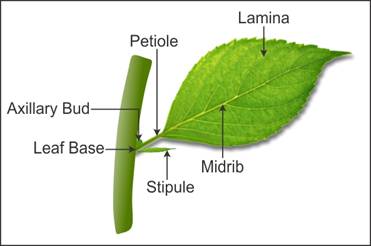
Q53. What type of placentation is seen in
sweet pea?
Solution
In marginal placentation, the placenta
forms a ridge on the ventral suture of the ovary and the ovules are borne on
this ridge.
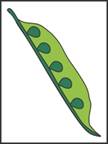 Such placentation is seen in pea.
Such placentation is seen in pea.
 Such placentation is seen in pea.
Such placentation is seen in pea.
Q54. Describe
the gynoecium of a typical flower.
Solution
The
gynoecium is the female reproductive part of a typical flower. It is made of
one or more carpels.
A carpel
consists of the following three parts:
1. Ovary:
It is the enlarged basal part of the flower.
Each
ovary bears one or more ovules attached to the placenta.
2. Style: The style is a tube-like structure
which connects the ovary to the stigma.
3.
Stigma: It is the receptive surface for pollen grains.
If the
carpels are free from one another, then they are called apocarpous. If they
are fused, then they are called syncarpous.NA
Q55. Name the
meristem from which leaves originate.
Solution
Leaves
originate from the shoot apical meristem.
Q56. Define adventitious
roots.
Solution
Roots which develop
or arise from the other parts of the plant but not from the radical are called
adventitious roots.
Q57. Rhizomes which grow vertically upwards
are
Solution
A root stock is a part of a plant which
is underground. From the root stock, the aboveground growth can develop. The
rhizome is one such growth which rises from the root stock.
Q58. Trimerous flower, superior ovary and axile placentation are the
characteristics of
Solution
Characters of family Liliaceae:
1. Leaves are mostly basal, alternate, linear, and exstipulate with
parallel venation.
2. Inflorescence is solitary/cymose. Flowers are often in umbellate
clusters.
3. Flowers are bisexual, actinomorphic and trimerous.
4. Perianth: There are six (3+3) tepals which are often united into a tube.
Valvate aestivation is observed.
5. Androecium: Stamens are six, 3+3 in number.
6. Gynoecium is tricarpellary and syncarpous. Ovary is superior,
trilocular with many ovules and with axile placentation.
7. Fruits are capsule-shaped and rarely berry.
8. Seed is endospermous.
Q59. Plants with the given floral diagram
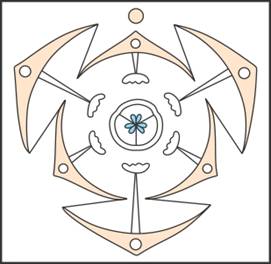

Solution
The given floral diagram indicates family Liliaceae. Medicinal and perennial plants belong to this family.
Q60. Differentiate
between pinnately compound leaves and palmately compound leaves.
Solution
Pinnately
Compound Leaves
Palmately
Compound Leaves
1. Leaflets are present on a
common axis, i.e. on a rachis.
1. Leaflets are attached to the
tip of the petiole.
2. Example: Neem
2. Example: Silk cotton
Q61. Name the three
regions of the root.
Solution
The three regions of the root are
1. Region of meristematic activity
2. Region of elongation
3. Region of
maturation
Q62. Explain the parietal type of placentation with the help of a diagram.
Solution
In parietal placentation, the ovules develop on the inner wall of the ovary. The ovary is one-chambered, but it becomes two-chambered due to the formation of the false septum.
The parietal type of placentation is seen in mustard flower.
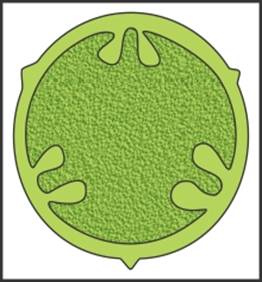

Q63. Describe the gynoecium of ground nut.
Solution
In ground nut, the ovary is superior, monocarpellary and unilocular with many ovules. The gynoecium has a single style.
Q64. A family delimited by the type of inflorescence is
Solution
Asteraceae is characterised by a head or capitulum inflorescence
consisting of a few or large number of flowers arranged on an axis surrounded
by involucral bracts.
Q65. Define
leaf.
Solution
A
lateral, generally flattened structure which is borne on the stem is called a
leaf.
Q66. A fibrous root system is excellent for
Food
storage
Nitrogen
fixation
Absorbing
water from deeper layers of soil
Providing
good anchorage for the plant
Solution
The main functions of fibrous roots are
(i) Absorption of water and minerals from
the soil
(ii) Providing a proper anchorage to plant parts
(iii) Storing reserve food material
(iv) Synthesis of plant growth regulators
Q67. Hypanthodium is
Solution
Hypanthodium is a type of inflorescence in
which the axis becomes fleshy and pear-shaped with a hollow cavity inside.
Example: Ficus
Q68. State the function
of root hair.
Solution
Root hair absorbs
water and minerals from the soil.
Q69. Distinguish between the families Solanaceae and Liliaceae on the basis of gynoecium.
Solution
Differences between Solanaceae and Liliaceae on the basis of their gynoecia.
Solanaceae
Liliaceae
1. Gynoecium is bicarpellary.
1. Gynoecium is tricarpellary.
2. Ovary is bilocular.
2. Ovary is trilocular.
3. It shows the presence of swollen placenta.
3. It shows axile placentation.
Q70. Draw a well-labelled diagram of the regions of the root tip.
Solution
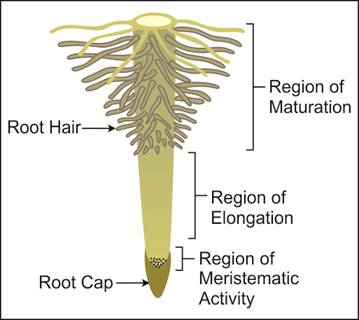
Q71. Ginger is an underground stem. It is distinguished from the root
because
Solution
A root does not have nodes and internodes, while a stem is characterised
by nodes and internodes.
A node is a region on the stem from which leaves develop, while an
internode is the region between two nodes.
Because ginger shows the presence of node and internode, it is a
modified underground stem.
Q72. What is modification of roots? Write the modification of roots found in the following plants:
(a) Maize
(b) Carrot
(c) Banyan tree
(d) Rhizophora
Solution
The roots in some plants are modified for support, storage of food and respiration.
(a) Maize: Stilt roots arise from the nodes of the stem to support the plant.
(b) Carrot: Roots are swollen and store food.
(c) Banyan Tree: Prop roots arise to support the tree.
(d) Rhizophora: Roots arise above the ground to obtain oxygen for respiration.
Q73. The thorn of Bougainvillea and the tendril of Cucurbita are examples
of
Solution
Homologous organs are the organs which exhibit anatomical similarities
but perform different function.
The thorn of Bougainvillea and the tendril of Cucurbita are
modifications of stem. Both arise from the axillary bud. Thorns provide
protection to plants, while tendrils provide support to the climbing plant.
Q74. Define
venation.
Solution
The
arrangement of veins and veinlets in the lamina of the leaf is called
venation.
Q75. New banana plants develop from
Solution
A sucker is the modification of a stem which originates from the basal
and underground portion of the main stem. Examples: Banana, Chrysanthemum
Q76. Name the
plants whose stems are modified to store food.
Solution
Plants
whose stems are modified to store food are potato, ginger, turmeric, Colocasia and Zaminkand.
Q77. What is a
compound leaf? Give one example.
Solution
When the
incisions of the lamina reach the midrib and break the main leaf into many
leaflets, such a leaf is called a compound leaf.
Example:
Neem
Q78. Differentiate
between marginal and axial placentation.
Solution
Marginal
Placentation
Axial
Placentation
1. The placenta is in the form of
a ridge along the ventral suture of the ovary, and ovules develop on this
ridge.
1. The placenta is axial, i.e. develops on
the axis, and ovules are attached to the placenta in a multilocular form.
2. Example: Pea
2. Example: Tomato
Q79. A simple cluster of radial leaves with exstipulate and parallel venation and cyme or umbel inflorescence are the characteristics of
Solution
Characters of family Liliaceae:
1. Leaves are mostly basal, alternate, linear, and exstipulate with parallel venation.
2. Inflorescence is solitary/cymose. Flowers are often in umbellate clusters.
3. Flowers are bisexual, actinomorphic and trimerous.
4. Perianth: There are six (3+3) tepals which are often united into a tube. Valvate aestivation is observed.
5. Androecium: Stamens are six, 3+3 in number.
6. Gynoecium is tricarpellary and syncarpous. Ovary is superior, trilocular with many ovules and with axile placentation.
7. Fruits are capsule-shaped and rarely berry.
8. Seed is endospermous.
Q80. Which plant will lose its economic value if its
fruits are produced by induced parthenocarpy?
Solution
The edible part of pomegranate is the testa.
It is not formed if fruits are produced by parthenocarpy. However, in fruits
such as grapes, induced parthenocarpy is beneficial
as they contain seeds.
Q81. Define
placentation.
Solution
The
arrangement of ovules within the ovary is known as placentation.
Q82. State the
name of the family of plants where flowers show valvate aestivation and
tepals are often united in a tube.
Solution
Liliaceae
Q83. What are
thorns? Give one example of a plant in which thorns are found.
Solution
Thorns
are the modified axillary buds of the stem. Thorns are found in citrus
plants.
Q84. What are
bracteate and ebracteate flowers?
Solution
Flowers
with bracts (i.e. reduced leaf found at the base of the pedicel) are called
bracteate flowers, and ebracteate flowers are the flowers without bracts.
Q85. Name the
reproductive organs of a typical flower.
Solution
Androecium
and gynoecium are the reproductive organs of a typical flower.
Q86. Roots of which plant contain an oxidising agent?
Solution
The roots of soyabean contain leghaemoglobin. Their main function is
to help in the transport of oxygen to the respiring symbiotic bacterial cells
in a manner analogous to haemoglobin which transports oxygen to respiring
tissues in animals.
Q87. Draw a
diagram of a hypogynous flower.
Solution
Hypogynous
flower:
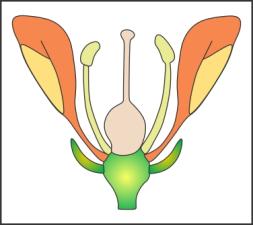

Q88. Name the region of
the root whose epidermal cells form root hair.
Solution
The epidermal cells
of the region of maturation form root hair.
Q89. Describe
epipetalous stamens.
Solution
When the
stamens are attached to the petals, they are called epipetalous stamens.
Q90. Describe the arrangement of calyx and corolla of sun hemp.
Solution
Calyx of sun hemp:
1. There are five sepals. It is gamosepalous and shows imbricate aestivation.
Corolla of sun hemp:
1. There are five petals. It is polypetalous consisting of posterior standard, two lateral wings and two anterior petals forming a keel. It exhibits vexillary aestivation.
Q91. How is
fusion indicated in a floral formula?
Solution
Fusion in
a floral formula is indicated by enclosing the figure in brackets.
Q92. Describe
the floral characters of the family Solanaceae.
Solution
The
floral characters of the family Solanaceae are as follows:
1.
Inflorescence is solitary, axial or cymose.
2.
Flowers are bisexual, actinomorphic.
3. Calyx:
Five sepals, gamosepalous. It shows valvate aestivation.
4.
Corolla: Five petals, gamopetalous. It shows valvate aestivation.
5.
Androecium: Five stamens, epipetalous.
6.
Gynoecium: Superior, bicarpellary, syncarpous ovary. Ovary is bilocular with
many ovules.NA
Q93. Define
epiphyllous stamens.
Solution
Epiphyllous
stamens are the ones which are attached to the perianth.
Q94. State the type of
root in sweet potato which stores food.
Solution
Adventitious roots
in sweet potato are swollen to store food.
Q95. Name the
plants of the family Solanaceae which yield each of the following.
(a) Food
(b)
Fumigatory
(c) Spice
(d)
Medicine
Solution
(a) Food
- Tomato
(b)
Fumigatory - Tobacco
(c) Spice
- Chilli
(d)
Medicine - Belladonna
Q96. Define
the following and give one example of each:
(a)
Bisexual flower
(b)
Unisexual flower
Solution
(a)
Bisexual flower: It is a flower in which both androecium and gynoecium are
present.
Example:
Tulip
(b)
Unisexual flower: It is a flower with only androecium or gynoecium.
Example:
Flower of papaya plant
Q97. Select the incorrect statement regarding a fusiform
root.
Solution
Secondary roots arise from the thin apical part of the tap root. This
is a characteristic of a napiform root.
Q98. State the
significance of the floral formula.
Solution
Significance
of floral formula:
1. The
floral formula provides information about the number of petals of a flower,
their arrangement and the relation they have with one another.
2. It
also shows the cohesion and adhesion within parts of whorls and between whorls.
Q99. Name the
accessory organs of a typical flower.
Solution
Calyx and
corolla are the accessory organs of a flower.
Q100. Draw the
floral diagram for the members of the family Liliaceae. Also, write the
floral formula of the family.
Solution
Floral
diagram for the members of the family Liliaceae:
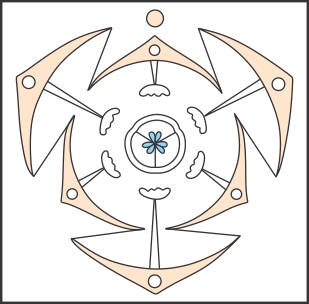 Floral
Formula:
Floral
Formula: 
 Floral
Formula:
Floral
Formula:
Q101. Define
apocarpous gynoecium.
Solution
When more
than one carpel is present, they may be free. Such a gynoecium is known as an
apocarpous gynoecium.
Q102. How is
adhesion indicated in a floral formula?
Solution
In a
floral formula, adhesion is indicated by drawing a line above the symbols of
the floral parts.
Q103. Describe the
different regions of the root.
Solution
The different regions of the root are as follows:
1. Root cap:
It covers the apex of roots which grow through the soil.
2. Region of Meristematic Activity:
This region is a few millimetres above the root cap.
The cells are thin-walled and small with dense
protoplasm. The cells divide repeatedly.
3. Region of Elongation:
This region is proximal to the region of meristematic
activity.
The cells in this region undergo rapid elongation
and enlargement.
This zone is responsible for the growth in length of
the root.
These cells gradually differentiate and mature.
4. Zone of Maturation:
The zone of maturation is proximal to the zone of
elongation.
Its epidermal cells
give rise to root hair cells which absorb water from the soil.
Q104. Name two plants
whose tap roots are modified to store food.
Solution
Carrot
Turnip
Q105. What does a dot represent in a
floral diagram?
Solution
A dot in the floral diagram
represents the position of the flower axis with respect to the flower.
Q106. What is the root
cap? State its function.
Solution
The root cap is the
structure which is thimble-like and covers the root apex. It protects the
tender apex of the root while it makes its way through the soil.
Q107. Describe
the floral formula.
Solution
A floral
formula is a representation of different parts of a flower and its
arrangement by using certain symbols.
Symbols
Part indicated by the symbol
Br
Bracteate
K
Calyx
C
Corolla
A
Androecium
G
Superior Ovary (Gynoecium)
 Inferior Ovary (Gynoecium)
Inferior Ovary (Gynoecium)
 Male Flower
Male Flower
 Female Flower
Female Flower
 Bisexual Flower
Bisexual Flower
 Actinomorphic Flower
%
Zygomorphic Flower
Fusion is
indicated by enclosing the figure in brackets.
Adhesion
is indicated by drawing a line above the symbols of the floral parts.
Actinomorphic Flower
%
Zygomorphic Flower
Fusion is
indicated by enclosing the figure in brackets.
Adhesion
is indicated by drawing a line above the symbols of the floral parts.
Q108. Describe the structure of a monocotyledonous seed.
Solution
The seed coat which covers the seed is membranous and fused with the cell wall.
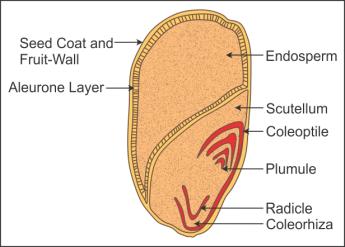 The endosperm is bulky, and it serves as the food reserve.
The outer covering of the endosperm is a proteinous layer called the aleurone layer.
A small embryo is located in a groove at one end of the endosperm.
A large shield-shaped cotyledon called the scutellum is present.
The embryo has a short axis with the radicle and plumule.
The radicle and plumule are enclosed in sheaths called coleorhiza and coleoptile, respectively.
The endosperm is bulky, and it serves as the food reserve.
The outer covering of the endosperm is a proteinous layer called the aleurone layer.
A small embryo is located in a groove at one end of the endosperm.
A large shield-shaped cotyledon called the scutellum is present.
The embryo has a short axis with the radicle and plumule.
The radicle and plumule are enclosed in sheaths called coleorhiza and coleoptile, respectively.
 The endosperm is bulky, and it serves as the food reserve.
The outer covering of the endosperm is a proteinous layer called the aleurone layer.
A small embryo is located in a groove at one end of the endosperm.
A large shield-shaped cotyledon called the scutellum is present.
The embryo has a short axis with the radicle and plumule.
The radicle and plumule are enclosed in sheaths called coleorhiza and coleoptile, respectively.
The endosperm is bulky, and it serves as the food reserve.
The outer covering of the endosperm is a proteinous layer called the aleurone layer.
A small embryo is located in a groove at one end of the endosperm.
A large shield-shaped cotyledon called the scutellum is present.
The embryo has a short axis with the radicle and plumule.
The radicle and plumule are enclosed in sheaths called coleorhiza and coleoptile, respectively.
Q109. Define
inflorescence. On what basis are the two types of inflorescences identified?
Explain the two types of inflorescences.
Solution
The
arrangement of flowers on the floral axis is called an inflorescence.
Based on
whether the apex gets converted into a flower or it continues to grow, the
two types of inflorescences are identified as racemose and cymose.
The two
types of inflorescences are as follows:
1.
Racemose inflorescence: The main axis grows and the flowers grow laterally in
acropetal succession.
2. Cymose
inflorescence: The main axis terminates in a flower. Flowers are borne in
basipetal order. The main axis has limited growth.
Q110. What do
the following symbols in a floral formula represent?
(a) Br
(b)  (c)
(c)  (d) K
(d) K
Solution
(a) Br -
Bracteate stem
(b)  - Actinomorphic flower
(c)
- Actinomorphic flower
(c)  - Bisexual plant
(d) K -
Calyx
- Bisexual plant
(d) K -
Calyx
Q111. Distinguish
between zygomorphic flower and actinomorphic flower.
Solution
Zygomorphic
Flower
Actinomorphic
Flower
1. The flower can be divided into two
similar halves in one particular plane.
1. The flower can be divided into two equal
radial halves in any radial plane passing through the central axis of the
flower.
2. Examples: Mustard, Datura
2. Examples: Gulmohar, Pea
Q112. Name the
proteinaceous layer present in a monocotyledonous seed.
Solution
The
aleurone layer is a proteinaceous layer present in a monocotyledonous seed.
Q113. What is
aestivation? Distinguish between valvate aestivation and twisted aestivation.
Solution
Aestivation
is the mode of arrangement of sepals or petals in a floral bud with respect
to the other members of the same whorl.
Valvate
Aestivation
Twisted
Aestivation
1. Sepal or petals in a whorl
just touch one another. They do not overlap.
1. One margin of the floral
appendage overlaps the margin of the next appendage.
2. Example: Calotropis
2. Example: China rose
Q114. With
respect to the floral formula given below, identify the family and write its
floral characteristics.

Solution
The given
floral formula is of family Fabaceae.
The
floral characteristics of the family Fabaceae are as follows:
Inflorescence
is racemose.
Flowers
are bisexual and zygomorphic.
Calyx is
made of five sepals. It is gamosepalous. It exhibits imbricate aestivation.
Corolla
consists of five petals—a posterior standard, two lateral wings and two
anterior petals fused to form a keel.
Androecium
has ten diadelphous stamens. Anthers are dithecous.
Gynoecium:
Ovary is superior, monocarpellary. It has a single style and is unilocular
with many ovules.
Q115. Write the symbols for the following used in floral formula:
(a) Zygomorphic nature of flower
(b) Inferior ovary
Solution
(a) Zygomorphic nature of flower - %
(b) Inferior ovary - 

Q116. Define
aestivation. Explain different types of aestivation.
Solution
Aestivation
is the mode of arrangement of sepals or petals in a floral bud with respect
to the other members of the same whorl.
There are
four main types of aestivation. They are as follows:
1.
Valvate aestivation:
Sepals or
petals in a whorl just touch one another. They do not overlap one another.
 It is
observed in Calotropis.
2.
Twisted aestivation:
One
margin of the appendage overlaps the margin of the next appendage.
It is
observed in Calotropis.
2.
Twisted aestivation:
One
margin of the appendage overlaps the margin of the next appendage.
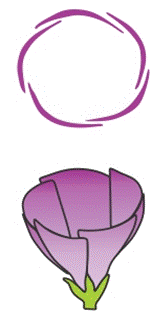 Such type
of aestivation is seen in lady’s finger, china rose and cotton.
3.
Imbricate aestivation:
Margins
of sepals or petals overlap one another but not in any particular direction.
Such type
of aestivation is seen in lady’s finger, china rose and cotton.
3.
Imbricate aestivation:
Margins
of sepals or petals overlap one another but not in any particular direction.
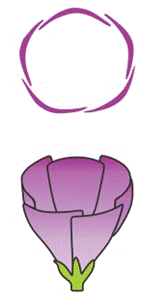 It is
seen in Gulmohar and Cassia.
4.
Vexillary aestivation:
It is
also known as Papilionaceous type of aestivation.
It is
seen in Gulmohar and Cassia.
4.
Vexillary aestivation:
It is
also known as Papilionaceous type of aestivation.
 There are
five petals. The largest petal (called standard) overlaps the two lateral
petals (called wings) which further overlap the two smallest anterior petals
(called keel).
There are
five petals. The largest petal (called standard) overlaps the two lateral
petals (called wings) which further overlap the two smallest anterior petals
(called keel).
 It is
observed in Calotropis.
2.
Twisted aestivation:
One
margin of the appendage overlaps the margin of the next appendage.
It is
observed in Calotropis.
2.
Twisted aestivation:
One
margin of the appendage overlaps the margin of the next appendage.
 Such type
of aestivation is seen in lady’s finger, china rose and cotton.
3.
Imbricate aestivation:
Margins
of sepals or petals overlap one another but not in any particular direction.
Such type
of aestivation is seen in lady’s finger, china rose and cotton.
3.
Imbricate aestivation:
Margins
of sepals or petals overlap one another but not in any particular direction.
 It is
seen in Gulmohar and Cassia.
4.
Vexillary aestivation:
It is
also known as Papilionaceous type of aestivation.
It is
seen in Gulmohar and Cassia.
4.
Vexillary aestivation:
It is
also known as Papilionaceous type of aestivation.
 There are
five petals. The largest petal (called standard) overlaps the two lateral
petals (called wings) which further overlap the two smallest anterior petals
(called keel).
There are
five petals. The largest petal (called standard) overlaps the two lateral
petals (called wings) which further overlap the two smallest anterior petals
(called keel).
Comments
Post a Comment